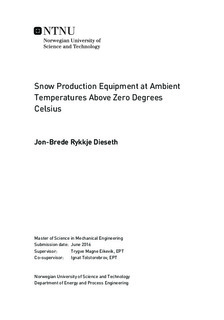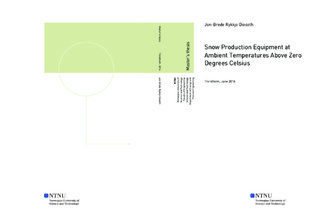| dc.description.abstract | In the perspective of increasing global temperatures, the periods with natural snow is shorter and in areas, the snow in the winter is disappearing. Therefore, it is important to produce snow at temperatures above 0°C to be able to maintain the snow activity close to the cities. Today, temperature independent snow machines(TIS) produce plate ice, flake ice and ice slurry in temperatures above 0°C. There are four manufacturers of TIS, IDE Technologies, TechnoAlpin(TA), SnowTech and SnowMagic Inc. The machines are using refrigerants with challenging properties, and CO2 is investigated as a substitute for these.
Vacuum and flake ice systems with a production capacity of 50 tons/day are modelled in EES, to investigate the thermodynamic performance at different ambient temperatures. The flake ice model shows that a single stage system(SCS) consumes less energy than a two-stage system(TCS) in ambient temperatures below 14°C. The U-value and ice growth rate for the flake ice drum(FID) are highly dependent on the ice thickness. Ice has high thermal resistance, and dictates the heat transfer from water to CO2 rather than the metals or the refrigerants. The vacuum model shows that a two stage system(TVS) is more efficient than a single stage system(SVS) regardless of the ambient temperature. A cascade system with CO2 is more energy intensive than the two previous systems. The most efficient vacuum system consumes just 20,8% of the energy required by the least efficient flake ice system. In terms of operation costs, the snow from the flake ice system is 4,8 times more expensive than from the vacuum systems. However, the investment costs are much higher for the vacuum system. Both the SCS and TCS is more energy efficient than the TA SF100. The energy consumption is 3,4% and 1,8% lower, respectively. A comparison between the vacuum models and existing machines is difficult, due to little known information about the existing machine.
COMSOL was used to do calculations on the FID. The results reveal that increasing the number of refrigerant pipes in the FID above 200, do not affect the temperature distribution on the freezing surface too much. In addition, the thickness can be optimized regarding the structural strength, rather than the heat transfer.
It is suggested to work further with improving the EES- and COMSOL models, investigate heat recovery possibilities, improving the efficiency of the systems, estimating the life cycle cost, look into operation strategies to minimize the energy consumption, and to build prototypes. | |

